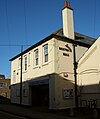
The Archbishop of Canterbury is the senior bishop and a principal leader of the Church of England, the ceremonial head of the worldwide Anglican Communion and the bishop of the Diocese of Canterbury. The current archbishop is Justin Welby, who was enthroned at Canterbury Cathedral on 21 March 2013. Welby is the 105th person to hold the position, as part of a line of succession going back to the "Apostle to the English" Augustine of Canterbury, who was sent to the island by the church in Rome in 597. Welby succeeded Rowan Williams.
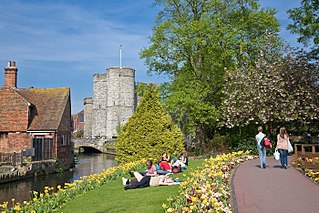
Canterbury is a city and UNESCO World Heritage Site, in the county of Kent, England; it was until 1974 a county borough. It lies on the River Stour. The city has a mild oceanic climate.

The City of Canterbury is a local government district with city status in Kent, England. As well as Canterbury itself, the district extends north to the coastal towns of Whistable and Herne Bay.

Westgate-on-Sea is a seaside town and civil parish on the south-east coast of Kent, England. It is within the Thanet local government district and borders the larger seaside resort of Margate. Its two sandy beaches have remained a popular tourist attraction since the town's development in the 1860s from a small farming community. The town had a population of 6,996 at the 2011 Census.

The Buffs (Royal East Kent Regiment), formerly the 3rd Regiment of Foot, was a line infantry regiment of the British Army traditionally raised in the English county of Kent and garrisoned at Canterbury. It had a history dating back to 1572 and was one of the oldest regiments in the British Army, being third in order of precedence (ranked as the 3rd Regiment of the line). The regiment provided distinguished service over a period of almost four hundred years accumulating one hundred and sixteen battle honours. In 1881, under the Childers Reforms, it was known as the Buffs (East Kent Regiment) and later, on 3 June 1935, was renamed the Buffs (Royal East Kent Regiment).
The Canterbury Festival is Kent's international festival of the arts. It takes place in Canterbury (England) and surrounding towns and villages each October/November and includes performances of a variety of types of music, art, comedy, circus, theatre, walks, talks and a Science strand. It has featured performances by Sir Willard White, Michael Nyman, Hugh Masekela, Rebecca Stephens, Texas, Joanna MacGregor, Van Morrison, Bryn Terfel, Sophie Ellis-Bextor, Tom Allen, Michael Mcintyre and Ned Sherrin and by ensembles such as the Polish National Radio Symphony Orchestra, the Tchaikovsky Symphony Orchestra, the Endellion and Brodsky Quartets, the Ensemble Cordial, Brass 10 and the Soweto Gospel Choir. Venues include Canterbury Cathedral, the Great Hall at Kent College, the Malthouse Theatre at The King's School, Westgate Hall and At Gregory's Centre for Music at Canterbury Christ Church University.
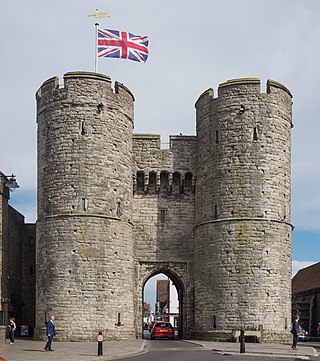
The Westgate is a medieval gatehouse in Canterbury, Kent, England. This 60-foot (18 m) high western gate of the city wall is the largest surviving city gate in England. Built of Kentish ragstone around 1379, it is the last survivor of Canterbury's seven medieval gates, still well-preserved and one of the city's most distinctive landmarks. The road still passes between its drum towers. This scheduled monument and Grade I listed building houses the West Gate Towers Museum as well as a series of historically themed escape rooms.
In countries whose armies are organised on a regimental basis, such as the army of the United Kingdom, a regimental museum is a military museum dedicated to the history of a specific army regiment.
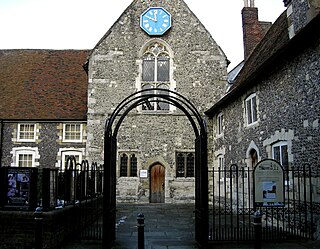
The Canterbury Heritage Museum was a museum in Stour Street, Canterbury, South East England, telling the history of the city. It was housed in the 12th-century Poor Priests' Hospital next to the River Stour. The museum exhibited the Canterbury Cross and contained a gallery dedicated to Rupert the Bear, whose creator Mary Tourtel lived in Canterbury. It held regular events and exhibitions of local and national interest. The museum closed in 2018. It has since re-opened as The Marlowe Kit; an escape room, exhibition and creative space.
The Royal East Kent Yeomanry was a British Army regiment formed in 1794. It saw action in the Second Boer War and the First World War.

The Queen's Own West Kent Yeomanry was a British Army regiment formed in 1794. It served in the Second Boer War and the First World War. It amalgamated with the Royal East Kent Yeomanry to form the Kent Yeomanry in 1920.

The Seaside Museum Herne Bay is a local museum in Herne Bay, Kent, England. It was established in 1932 and is notable for being a seaside tourist attraction featuring local archaeological and social history, for featuring the history of the town as a tourist resort, for its local art exhibitions, and for its World War II bouncing bomb. The management of the Museum was awarded by Canterbury City Council to the Herne Bay Museum Trust, who reopened it in July 2015 as The Seaside Museum Herne Bay.

The Canterbury Roman Museum in Canterbury, Kent, houses a Roman pavement which is a scheduled monument, in the remains of a Roman courtyard house which itself is a grade I listed building. The pavement was discovered after World War II bombing, and has been open to the public since 1946. The museum was established in 1961. It houses many excavated artifacts from Roman Canterbury, including the important late Roman silver hoard known as the Canterbury Treasure, together with reconstructions of the Roman town.
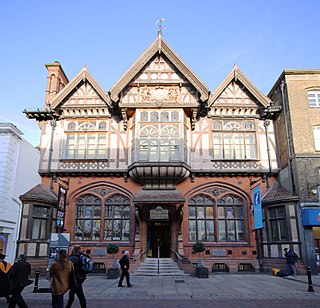
The Beaney House of Art and Knowledge is the central museum, library and art gallery of the city of Canterbury, Kent, England. It is housed in a Grade II listed building. Until it closed for refurbishment in 2009, it was known as the Beaney Institute or the Royal Museum and Art Gallery. It reopened under its new name in September 2012. The building, museum and art gallery are owned and managed by Canterbury City Council; Kent County Council is the library authority. These authorities work in partnership with stakeholders and funders.

Herne Bay Pier was the third pier to be built at Herne Bay, Kent for passenger steamers. It was notable for its length of 3,787 feet (1,154 m) and for appearing in the opening sequence of Ken Russell's first feature film French Dressing. It was destroyed in a storm in 1978 and dismantled in 1980, leaving a stub with sports centre at the landward end, and part of the landing stage isolated at sea. It was preceded by two piers: a wooden deep-sea pier designed by Thomas Rhodes, assistant of Thomas Telford, and a second shorter iron version by Wilkinson & Smith.
The Kent Museum of Freemasonry, is a museum in St Peters Place, Canterbury, Kent with a rare collection of masonic exhibits of national and international importance.

Canterbury Christ Church University (CCCU) is a public university located in Canterbury, Kent, England. Founded as a Church of England college for teacher training in 1962, it was granted university status in 2005.

Lydia Cecilia Hill, known as Cissie Hill or Cecily Hill, was an English cabaret dancer notable for being a favourite of Ibrahim, Sultan of Johor and for being briefly engaged to him. A new Art Deco house, Mayfair Court, was funded for her in Herne Bay, Kent, by the Sultan. She was killed during World War II in her native Canterbury at the age of 27 in a German airstrike. There is an elaborate, marble monument on her grave in Herne Bay cemetery, Eddington, paid for by the Sultan.

The Church Street drill hall is a former military installation in Brighton. It is a Grade II listed building.

Canterbury Guildhall, formerly the Church of the Holy Cross, is a municipal building in St Peter's Place in Canterbury, Kent, England. The structure, which is the meeting place of Canterbury City Council, is a Grade II* listed building.










